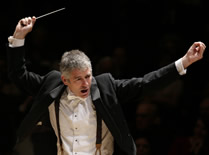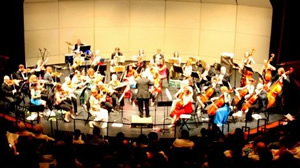Last minute substitutions have given many young artists big breaks. Bruno Walter’s illness on November 14, 1943, gave Leonard Bernstein the spotlight with the New York Philharmonic with short notice. In 1985, Itzhak Perlman’s illness in London gave eleventh-hour substitute Gil Shaham, a Juilliard student, prominent exposure. Replacing a scheduled soloist can be a godsend to the prepared. Too-slow post 9-11 visa processing kept noted French pianist Michel Dalberto from honoring his solo commitment for the Greensboro Symphony Orchestra’s final pair of concerts and a Sitkovitsky and Friends chamber music concert. Music Director Dmitri Sitkovetsky decided to retain the French theme of the first half of the orchestral concert, and he chose as his soloist rising violinist Stefani Collins, a Greensboro resident and an eleventh grade student at the NC School of the Arts. The student of Sarah Johnson has racked up an impressive array of awards and concert appearances. During post-concert remarks in Greensboro War Memorial Auditorium on May 4, Sitkovetsky noted what astonishing artistic progress Collins had made since he first heard her when he was a violin soloist at a concert led by Stuart Malina, his predecessor.
Debussy’s La Mer opened the concert. Sitkovetsky considers the seminal French composer one of the 20th century’s greatest, and this was reflected in the great care the conductor lavished on every section of the orchestra. String ensemble was in lock step, each section playing as one and responding instantly to every change of bowing and dynamics. The phrasing was outstanding, with climaxes perfectly built up and released. The myriad of instrumental color was given its full value. The woodwinds played brilliantly. The horn section was terrific, and all the brasses responded with great sensitivity. The radiant trumpet solo was played by Anita Cirba. Closely-matched playing within sections has been constantly refined by the conductor. Given a hall in which many of the musicians cannot hear each other from across the stage, co-ordination among the sections was striking. A case in point was in the first movement of the Debussy, where the depths of the sea are suggested by a phrase during which the entire horn and cello sections phrase as one. The GSO musicians did this perfectly, with every nuance carefully molded by Sitkovetsky.
There is a caveat. During the playing of the Debussy, color photos of the sea – and rather too many of the seashore – were projected on a screen above the musicians. The GSO, like many orchestras, is experimenting with adding visual elements in hopes of attracting the “MTV” generation. Picture quality was much improved over the last outing, and far more were in focus. Personally, however, I found them distracting and their specificity too limiting to the imagination. Considering that a whole generation has been weaned on music videos-images in motion, I fear static photos may fail to hook the hyper audience.
Stefani Collins interpreted her two selections with musical insights well beyond her chronological age. She turned 17 on the day of the repeat concert (May 6). Playing her modern Italian Frosali violin (1942), she produced a warm, full tone that filled the hall. Her multiple stops were breath-taking and her intonation was faultless. At the end of Ernest Chausson’s lovely Poème, Op. 25, her execution of the famous series of trills – trills that begin on a low note and progress higher and higher yet – was stunning. Her performance of Ravel’s well-known Tzigane was earthy; it was played with panache and verve. Sitkovetsky secured beautifully balanced accompaniment and the musicians wove a texture of great delicacy and refinement, especially in the Chausson. Triangle music lovers will be able to hear Collins’ Tzigane when she is guest artist with the NC Symphony in Cary, in June.
In response to a standing ovation from a full house, Collins presented as an encore an elegant treatment of the Saraband from the Second Partita of J. S. Bach. Her tempo was slightly slower than that to which I am accustomed but her individual approach was refreshing.
The orchestra’s high level of individual technical accomplishments and inter- and intra-sectional co-ordination were sustained throughout the joy-filled performance of Beethoven’s Symphony No. 6 in F, Op. 68, known as the “Pastoral.” Sitkovetsky’s tempos reflected the informed approach of the early music movement. The quickened pace was apt for the first movement’s portrayal of emotions upon arriving in the country: the tempo did not drag. There was no “cooling of the heels” in the gurgling waters of the second movement’s “Scene by the Brook.” Every section was fully alert and committed and important solos were strongly characterized. One could imagine the cuckoo, quail, and nightingale, conjured up by the woodwinds, dusting themselves in the trail’s dust. Perhaps Viennese rustics, performing a heavy-footed dance like our mountain cloggers, inspired Beethoven’s countrified scherzo. The Triad’s recent bout with tempestuous winds was recalled during the buildup and full outburst of the thunderstorm of the fifth movement. Nothing dragged or seemed anti-climatic during the finale as Sitkovetsky tied together the strands of the composer’s pantheistic hymn to Nature.
Note: CVNC‘s first review of Stefani Collins was at the Eastern Music Festival in 2003; see https://www.cvnc.org/reviews/2003/july/EasternMusicV.html. A review of one of her four NC Symphony-NCSA concerto competition performances of Dvorák’s Violin Concerto is at https://cvnc.org/reviews/2004/september/RisingStarNewHall.html.












